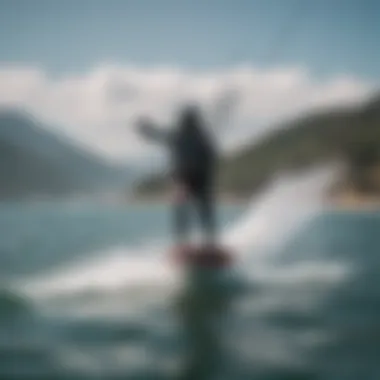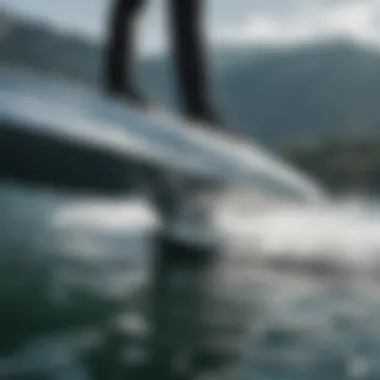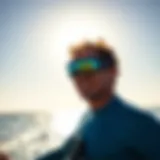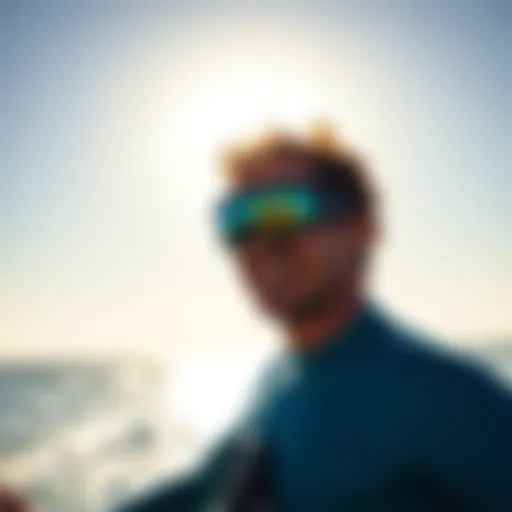Mastering Foiling Water: Gear and Techniques Guide


Intro
Foiling water activities, especially in kiteboarding, have surged in popularity and intrigue over the past few years. Riders are drawn not only by the thrill of gliding above the surface but also by the unique dynamics that hydrofoiling brings to the sport. Whether you're a seasoned kiteboarder looking to elevate your game or a beginner keen on learning, understanding the nuances of foiling is essential. This guide will provide insights into the essential gear, techniques, and ideal conditions needed for an enjoyable and safe experience on the water.
The sport has its roots in the traditional kiteboarding scene but has evolved into something that combines skill, strategy, and innovation. Riding on a hydrofoil offers a distinct sensation and performance advantages, making it a favorite choice among enthusiasts. Let’s dive right into the gear insights to ensure you're well-equipped for your foiling journey.
Foreword to Foiling Water
The world of foiling water represents an exciting frontier in the realm of kiteboarding, merging speed, finesse, and the thrill of flight with the challenges of the sea. For kiteboarders, understanding the intricacies of foiling not only enhances their performance but also enriches their connection to the ocean. The delicate balance between gear, technique, and environmental conditions can make or break a foiling session.
Foiling offers several unique benefits, including the ability to glide over the water with minimal drag, allowing riders to harness even the lightest winds. This creates opportunities to kiteboard when it might otherwise be impossible. Moreover, the sensation of being lifted above the water offers an unparalleled thrill, transforming an ordinary day on the water into an extraordinary experience.
However, venturing into foiling requires careful consideration of various elements. Knowing how to select the right equipment, understanding the science behind hydrofoils, and mastering specific techniques are crucial aspects that every kiteboarder should grasp.
Understanding the Basics of Foiling
At its core, foiling revolves around the principle of hydrofoils lifting the board above the water’s surface. A hydrofoil consists of a wing-like structure submerged underwater, creating lift as the water flows over it. The lift generated not only enhances speed but also significantly reduces resistance, permitting smoother rides through choppy conditions.
The fundamental components of foiling include the hydrofoil itself, which is typically attached to the board, and the mast connecting the foil to the board. Riders must first familiarize themselves with their equipment, learning how each part interacts under various conditions.
In addition to understanding how the equipment works, balance plays a key role in successful foiling. Riders often need to adjust their stance in response to changes in wind and water conditions.
The Science Behind Hydrofoils
Dive deeper into the mechanics of hydrofoils and you’ll uncover a world not unlike flying. The shape and design of the hydrofoil directly influence how much lift it generates and how efficiently it cuts through the water. There are different types of foils, each suited for varying conditions and styles, but they all rely on some fundamental principles of fluid dynamics.
When considering the design of a hydrofoil, factors such as wing shape, surface area, and angle of attack come into play. A larger surface area coupled with an optimal angle of attack can produce greater lift; however, it may also lead to increased drag in some cases. Thus, various kiteboarders might gravitate towards specific types or designs based on their experience level, riding style, and the conditions they anticipate.
To sum up, understanding the core concepts of foiling is crucial for both novices and seasoned riders looking to enhance their skills. The balance of gear, technique, and conditions is what ultimately makes foiling an exhilarating experience.
The Equipment for Foiling
Choosing the right equipment is essential for a successful foiling experience. Proper gear not only enhances performance but also ensures safety when navigating water's unpredictable elements. In the world of foiling, having the correct setup means the difference between a smooth ride and a series of frustrating tumbles. Whether you're just starting or have some experience under your belt, understanding the ins and outs of your gear transforms your time on the water.
Selecting the Right Hydrofoil
When it comes to foiling, the hydrofoil is the heart of the operation. Choosing the right hydrofoil involves several elements that can significantly impact your overall experience.
Foil Types
Foil types generally refer to the design and usage of a hydrofoil. You'll find options ranging from full foils to those specifically designed for kiteboarding. The most common types are freeride, surf, and race foils. Freeride foils are often preferred by beginners due to their stability and ease of use. They help riders catch the wind without much effort and are forgiving during early learning phases. In contrast, racing foils are long and thin, tailored for speed and expert riders who are looking for performance.
Some riders might feel overwhelmed choosing between so many types. It's crucial to consider what fits your style and need best. For instance, if you want to cover long distances with ease, a freeride foil stands out as a beneficial choice. However, if your sights are set on racing competitions, having a performance-oriented option may be what you need, though they come with a steeper learning curve.
Wing Shapes
The wing shape plays a pivotal role in how your foil performs. Expect to encounter variations like high aspect and low aspect wings. High aspect wings have a longer wingspan and narrow body, generating less drag while maximizing lift. This makes them ideal for speed and glide, often favored in racing scenarios.
On the other hand, low aspect wings, with their wider and shorter design, provide greater lift at lower speeds. Such wings cater to beginners keen on thrill and simplicity as they develop their skills handling the foil. Mixing and matching wing shapes can be fun but requires careful consideration to get the right fit based on the condition you are foiling in.
Material Considerations
The material of your hydrofoil affects weight, strength, and durability. Common materials include aluminum, carbon fiber, and various composites. Each has its unique set of attributes. For example, carbon fiber is lightweight and incredibly strong, making it a popular choice for serious racers wanting to maximize performance. However, its higher cost might deter casual riders.
Aluminum foils are often the go-to for those starting out. They offer a good balance of performance and affordability, plus, they can take a beating. The trade-off is in weight—the foil may be heavier, reducing some responsiveness and speed. Ultimately, identifying the right material tied to your goals and budget is vital for a rewarding foiling experience.
Kite Compatibility with Foiling
Not all kites work seamlessly with foiling; understanding kite compatibility can pave the way for a smoother ride. Several elements come into play here.


Kite Size
Kite size is about finding a balance; too small, and you may struggle to get up on the foil; too big, and you might get overpowered. For most beginners, a medium-sized kite can be a solid starting point, allowing for ease of handling and control on the water.
Understanding wind conditions is crucial for picking the right size kite. In lighter winds, larger kites perform better, while in strong winds, smaller kites can typically provide better control. An understanding of varying situations helps kiteboarders learn to adapt their approach and gain confidence.
Type of Kite
There are various types of kites, primarily classified as inflatable or foil kites. Inflatable kites are characterized by their "bulky" nature thanks to built-in air chambers, providing better performance in gusty conditions. They are easier to relaunch from the water, making them a favorite among beginners.
Foil kites offer a more streamlined profile, typically requiring a more experienced user to manage effectively. They tend to be lighter and can perform well in all wind conditions. These kites can be advantageous for experienced riders, especially in higher winds, but novices can find them tricky at first.
Bar and Lines
The bar and lines tie everything together. A well-designed bar gives you control over the kite's movements while ensuring safety. Bars come in various sizes and adjustments, a fundamental aspect that should align with your kite's size.
Lines should be durable and a length that complements your riding style. Shorter lines provide quicker maneuverability while longer lines offer more lift and range. Making sure these components match your kite setup is essential for maintaining both performance and safety on the water.
Safety Gear and Accessories
Despite the exhilaration that foiling brings, safety must never take a back seat. Investing in quality safety gear can safeguard against unforeseen circumstances during your riding sessions.
Impact Vests
Impact vests contribute an extra layer of protection in case of falls. These neoprene vests help disperse the force of impacts and keep you buoyant when in the water. They ease the fear of hitting the water too hard, especially while learning new tricks.
Moreover, many impact vests come with pockets for vital accessories like flotation devices, keeping everything compact and handy. The trade-off, however, can be on comfort; some might feel bulkier, especially for those looking to maximize agility.
Helmets
A helmet should not be disregarded in any outing. Safety helmets specifically designed for water sports can protect your head against unexpected falls or collisions. These helmets offer good flotation and a tough outer shell to safeguard your brain from any nasty bumps—the ultimate insurance in a fun but risky sport.
However, a common downside is that some helmets can be hot or restrictive, especially in warm weather. Finding a lighter, well-ventilated model can mitigate this issue, allowing you to focus more on your ride instead of discomfort.
Leashes
Leashes are an essential piece of equipment. They connect your kite's bar to the board, ensuring it doesn't float away if you fall off. Having a reliable leash adds peace of mind, allowing you to focus on the ride.
Leashes come in various lengths and materials, and durability should be a priority during your selection process. Cheap leashes may snap at the wrong time, costing you both gear and ride time. It's worth investing in a quality leash that can withstand high tension.
"Selecting the right equipment for foiling is not just essential for enhancing performance but also crucial for safety on the water."
With these considerations in mind, the right gear can significantly enhance your foiling experience, combining safety, performance, and, ultimately, fun.
Techniques for Successful Foiling
Mastering the art of foiling isn't just about getting on your board; it's about understanding the interplay of various techniques. This section aims to highlight how these techniques enhance your overall experience, improve your skill level, and ensure a safe ride. Successful foiling encompasses a range of aspects that need careful consideration, from getting started to mastering tricks. Understanding the fundamentals can make the difference between a bumpy ride and a graceful glide across the water.
Getting Started with Foiling
Initial Set-Up
When it comes to the initial set-up, precision is key. The way you configure your gear contributes significantly to your performance on the water. Getting the right angles on your hydrofoil and ensuring it's properly attached to your board can make all the difference. For instance, a well-angled foil helps in achieving lift earlier, allowing for a smoother lift-off. Careful consideration of these angles can turn a novice experience into an enjoyable one, rather than a frustrating attempt at balance.
The unique aspect of this paltry set-up lies in the adjustment of the foil's height. A higher elevation can lead to better speed; however, it requires more skill to maintain stability. Misjudging this can lead to a bruising dip into the water. Therefore, it becomes paramount to understand that finding that sweet spot is an essential part of your setup process.
Launching Techniques
Launching your foil is not merely a task; it’s an art form that resonates deeply within the foiling community. Proper launching techniques can significantly minimize time spent clumsily flopping about and maximize time soaring above the waves. A good launch often starts with a solid stance and an effective use of kite power.
It’s essential to be aware of the wind direction and how your kite will respond. Utilizing the correct line tension can help get you airborne more effortlessly. Still, a common pitfall is failing to gauge the wind speed appropriately. If the wind is too weak, launching can prove futile, while a strong gust can send an unprepared rider tumbling.


Mastering the Ride
Balancing on the Foil
Achieving balance on a hydrofoil is much like dancing on a tightrope; it demands focus and finesse. The entire ride hinges on how well you can distribute your weight. Shifting your weight too far forward can result in a too-quick descent back into the water, while leaning back can lead to a loss of speed. Finding that medium ground where you can feel comfortable enables a blissful experience gliding over the water.
One intriguing feature of balancing is using your legs effectively. Engaging your core and achieving to maintain a relaxed upper body encourages better weight distribution. This can ultimately prevent fatigue and provide a smoother ride. For newcomers, this may seem daunting, but with practice, it becomes intuitive.
Navigating Turns
Navigating turns while foiling can separate the dabblers from the dedicated. The maneuvering process requires an understanding of both body weight shifts and kite handling. As you approach a turn, it’s vital to lean into it with the correct posture. Placing your weight on the back foot allows for a sharper turn, while an improper stance could sway you into awkward spills.
The beauty of turns lies in their ability to provide a thrilling experience. A well-executed turn not only showcases skill but also elevates the overall enjoyment of foiling. Taking the time to practice and get comfortable with turning mechanics can provide smoother transitions that feel like art.
Tricks and Advanced Techniques
Jumping
The thrill of jumping can set your heart racing; it symbolizes freedom and mastery. It takes preparation and timing to get it right. Proper technique involves a synchronized effort between the position of your board, kite, and body at the moment of the jump. Timing requires you to pull on the lines at just the right moment before your board leaves the water.
One unique feature of jumping is the trajectory; you want a controlled ascent and decent, aiming to maintain stability while airborne. A mistake easily leads to plummeting back into the water. But when done correctly, it feels like flying, providing a rush that makes one crave more.
Surfing Waves
Surfing waves while foiling presents a different challenge altogether. It blends the finesse of kiteboarding with the art of wave riding, creating a mesmerizing experience. Riding a wave while on a foil requires keen observation of wave patterns as you'll have to adjust your positioning to either catch a rolling wave or ride off one.
What sets wave surfing apart is the increased sensitivity to balance; even small shifts can lead to dramatically different experiences. It might take time to learn to read the waves, but mastering this can significantly enhance your foiling repertoire.
Freestyle Elements
Freestyle elements in foiling introduce creativity into your ride. Tricks like spins, board flips, and grabs make foiling more than just a water sport; they enable you to express yourself while riding. Freestyle tricks usually require higher skill and control. Knowing how to combine speed and motion will add flair to your movements.
However, it's important to recognize that freestyle can lead to more falls and near-misses, making it a higher-risk aspect of foiling. Those willing to invest the time to learn and perfect these techniques often find the effort worthwhile as it can vastly elevate their experience on the water.
Understanding Foiling Conditions
Knowing how to read and understand the conditions for foiling is as essential as having the right gear. Weather and water conditions greatly influence your performance on the water. Without a proper grasp of these elements, even the best techniques may not yield the expected results.
Understanding foiling conditions allows kiteboarders to maximize safety and enhance their skills. Different water and wind situations require different approaches. Being prepared for these changes can prevent accidents and improve the overall experience on the water. This section delves into both ideal weather conditions and potential hazards that every kiteboarder must consider.
Ideal Weather and Water Conditions
Wind Speeds
Wind speed operates like the engine of a kite. Too little and your ride can stall; too much and it can become impossible to maintain control. Typically, wind speeds between 12 to 25 knots are favored for foiling. This range provides enough power for a solid lift without overwhelming the rider.
The key characteristic of wind speeds is their ability to change rapidly. Conditions can transform from gentle breezes to squalls in the blink of an eye. The unique feature here is the necessity of being keenly aware of local wind patterns before heading out. Many seasoned kiteboarders swear by local weather apps or monitoring sites, but it's advisable to have first-hand checks as well.
Understanding wind conditions directly influences your enjoyment. While a brisk wind might lift you straight off the water, too strong conditions can make control elusive.
Water Depth
Water depth plays a pivotal role in foiling, particularly for those using large hydrofoils designed to glide through deeper water. Shallow areas can obstruct the foil, causing abrupt and sometimes dangerous stops. A minimum of 3 feet of water is often recommended to ensure safety and functionality.
The key characteristic here is the necessary clearance for the foil to function correctly without hitting bottom obstacles. Deep water can provide smooth conditions, allowing better control when foiling. However, it can also mean a challenge for beginners who may find recovery more difficult after a fall. Make sure to choose spots that suit your skill level and setup.
Tides and Currents
Tides and currents often dictate the best times to go foiling. The effect of a rising tide creates a smoother surface, while a strong current can either enhance or impair your experience. The key characteristic of tides is their ability to bring in or sweep away changing water conditions, providing a variety of challenges and excitement.


Timing is everything. Riding against a high current can sap your energy before you even hit the waves, while the right conditions can create perfect riding situations. Understanding local tide charts and water movement patterns is essential. Unique features of the tides include how they bring different water features to life, such as waves or flat sections, which are important for practicing various maneuvers.
Identifying Potential Hazards
Obstacles Underwater
Areas you ride in can often hold hidden dangers lurking beneath the surface. Undertows, rocks, and even underwater structures can pose risks to your ride. Knowing where these obstacles lie allows you to navigate safely. Many kiteboarders make use of local knowledge and reports to steer clear of hazardous areas.
A key characteristic of underwater obstacles is their often unpredictable nature. They can change due to shifting sand or water levels. So, always be alert and scan your riding area to avoid unwanted surprises.
Changing Weather Patterns
Weather can turn south in a hurry. One moment you might be enjoying a pleasant day, the next, a storm could roll in. Sudden changes can catch you off guard if you’re not paying attention. Being aware of weather patterns helps you to avoid getting caught in severe conditions.
Monitoring real-time updates can be key. The unique feature of changing weather patterns is how quickly they can go from ideal to unsafe. A strong gust can swallow you up if you’re not adequately briefed on upcoming weather shifts. It's prudent to consider local forecasts before heading into the fray.
Always prioritize your safety. Choose conditions that align with your skills, and regularly consult local forecasts.
Common Challenges in Foiling
Foiling water can seem like a sleek ride on the surface, but there are bumps on the way that you should gear up to face. Acknowledging the common challenges in foiling is essential for improving your skills and ensuring safety. Problems like equipment failures and hurdles in personal abilities can seriously limit the enjoyment and satisfaction that comes from foiling. Addressing these issues equips you with the knowledge to navigate the waters effectively, allowing you to ride the foil with confidence.
Dealing with Equipment Failures
Preventive Maintenance
Investing in preventive maintenance for your foiling gear can save you a lot of headaches down the line. This involves regular checks and cleanings of the hydrofoil, kite, and other equipment, ensuring everything is functioning smoothly. Regularly checking for wear and tear is a standout characteristic of preventive maintenance. It’s beneficial because it can extend the longevity of your gear and prevent unexpected failures that could lead to accidents. For example, keeping an eye on the integrity of the foil wings and masts can help you catch issues before they become serious.
Unique to preventive maintenance is its focus on proactivity. It encourages a mindset where you anticipate potential issues and address them before they arise. In this article, you will see how adopting a maintenance routine can greatly enhance your overall foiling experience by avoiding costly repairs or safety hazards.
Emergency Procedures
No matter how well you maintain your equipment, emergencies can still happen. Knowing emergency procedures is vital for all foilers who aim to enjoy the sport safely. A critical characteristic of emergency procedures is their focus on quick response. They help you act swiftly to mitigate damage or injury during a malfunction or accident. This could mean knowing how to perform a controlled dump of air from your kite when experiencing difficulties.
The unique feature of having well-practiced emergency protocols is that they can instill calm under pressure. When faced with unexpected situations, being prepared enables you to react appropriately rather than panicking. Not only does this improve your safety, but it can also make a significant difference in how you handle the experience, transforming potential fear into control and confidence.
Overcoming Skill Barriers
Personal Techniques
Enhancing personal techniques can serve as a bridge over the skill barriers that many kiteboarders encounter. Focusing on mechanics — like foot positioning and body alignment — are crucial aspects of making progress in foiling. This aspect is key because personalizing your approach can help you discover what works best for your body and style. Tailoring techniques to fit your unique needs not only boosts your confidence but also enhances performance.
The unique aspect of refining personal techniques lies in the incremental improvements you make over time. You may not see changes overnight, but small steps can lead to a significant overall growth in your skills. This article emphasizes that patience and practice, combined with a willingness to adapt, can lead you to conquer those initial challenges that come with foiling.
Seeking Professional Coaching
When personal methods seem inadequate, seeking professional coaching is a smart route to take. A professional can pinpoint areas where you're struggling and provide tailored advice or specific tips to improve. The standout characteristic of professional coaching is its personalized feedback, which often unfolds in real-time during practice. This responsiveness makes it a popular choice for many kiteboarders.
The unique feature of engaging with a coach is the insight they provide based on experience. Coaches can help bridge the gap between where you are and where you want to be, offering shortcuts that come from years of experience. Through this article, the importance of investing in skilled coaching becomes apparent, as it can dramatically shorten the learning curve and elevate your abilities in foiling.
Finale and Future of Foiling
As we drift to the close of our exploration into the captivating realm of foiling water, it’s pivotal to pause and reflect on what we’ve gleaned. The world of foiling has witnessed remarkable transformation over the years, shaping a unique niche in kiteboarding and water sports, attracting a dedicated following among enthusiasts. With such advancements come the importance of recognizing not just the present state but also the future trajectory of foiling.
Innovation in Foil Design and Performance
Innovation stands at the heart of the foiling experience. The evolution of foil design has introduced materials that are lighter and stronger, providing riders with increased agility on the water. Modern constructions often utilize advanced carbon composites and new aluminum alloys to enhance performance and reduce the weight of the equipment. The development of wing shapes is particularly fascinating; designers are experimenting with different profiles that improve lift and reduce drag.
- Changes in Design: As experiment more, engineers have gathered extensive data to fine-tune the hydrodynamics of foils. This means that today’s setups can provide better lift at lower speeds, allowing riders to catch the breeze without needing to exert excessive effort.
- Performance Tracking: Electronic sensors embedded in modern foils can measure the foil's performance metrics in real-time. This data can be invaluable for anyone, from a casual rider to a competitive athlete looking to refine their skills.
As these innovations are met with increasing demand, the focus on safety has equally evolved. Riders can look forward to integrated safety features that make falls less daunting, and allow for smoother recoveries in rough conditions.
Foiling as an Evolving Sport
The community surrounding foiling is not static. As more people adopt the sport, it nurtures an environment rich with shared experiences. The camaraderie among practitioners leads to shared techniques and tips that elevate everyone’s game. Online forums and social media platforms, such as those found on Reddit and Facebook, are helping to spread knowledge, making it easier for newcomers to find their footing.
What sets foiling apart from traditional forms of kiteboarding is its unparalleled versatility. Riders can transition from flat water to waves, and even through challenging conditions, making it a robust choice for adventure seekers. As interest in foiling continues to burgeon, we may soon see even more competitive events dedicated specifically to this discipline, encouraging professional growth and providing more avenues for riders to showcase their skillsets.















